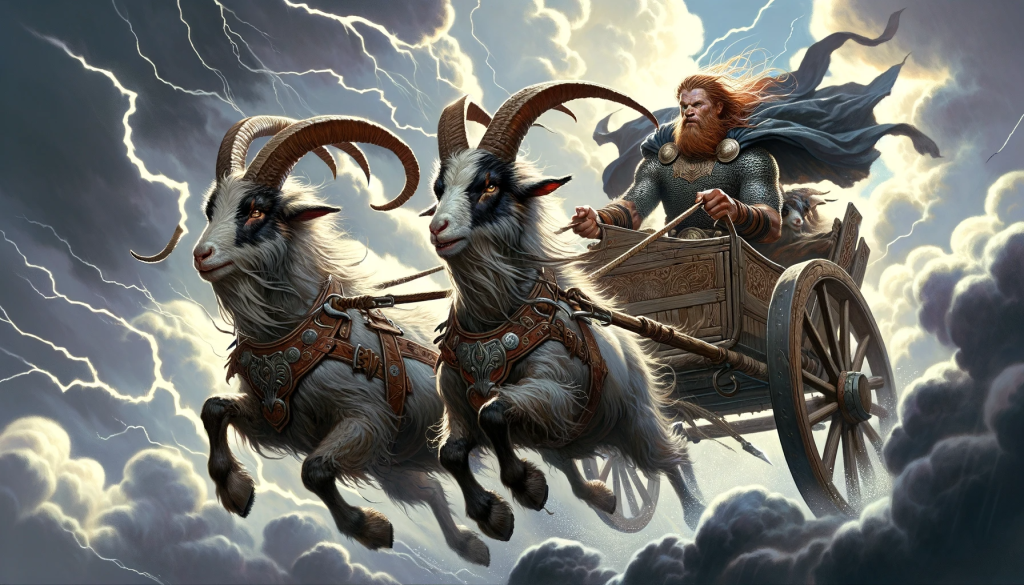The God of Thunder leads many adventures throughout the nine realms and, whenever possible, the Prince of Asgard rides in style: in his trusty chariot, pulled by his two goats, Tanngrisnir and Tanngnjóstr.
Tanngrisnir and Tanngnjóstr can be translated respectively to teeth-barer and teeth-grinder. As they pull Thor’s chariot, sparks and lighting erupt from its wheels, creating the sound of thunder and blue lightning over the skies, seen and heard from far away.

Yet, more than trusty beasts and companions, the goats were a constant source of nourishment, as they could be slain and revived at will by the God of Thunder, as described in the chapter 44 of the Prose Edda book Gylfaginning.
According to the tale, Thor and Loki were riding through Midgard in Thor's chariot, when they decided to stop at the home of a farmer to stay for the night. The farmer and his family were very poor, and they could not offer any food to Thor, who has been known on more than one occasion to eat an entire ox in a single meal.
Ever noble, Thor decided to kill his two goats and cook them for dinner. Thor slaughters his goats, skins them and puts them in a pot. When the goats are cooked, Loki and Thor sit down for their evening meal. Everyone was allowed to eat, but only on the condition that they did not break any of the bones.

Goat leg, by Chef Thor
At the end of the meal, Thor places the skins of the goats on the opposing side of the fire and tells the peasants to throw the bones of the goats in the goatskins. Likely influenced by Loki, the peasant's son Þjálfi takes one of the goat ham-bones and uses a knife to split it open, breaking the bone to get to the marrow.
By the next morning, before the break of dawn Thor wakes up and gets dressed. Thor takes his hammer Mjölnir, raises it and blesses the goat skins, resurrecting the goats.
To the God of Thunder dismay, one of the goats was lame in the hind leg. Noting this new lameness, Thor rages and exclaims that someone has broken the ham-bone during the meal the night before.

The peasants became rightly terrified as they saw the anger on Thor’s face while the God's hand clenched Mjolnir so tightly that his knuckles went white. The poor farmers threw themselves at the Thor's mercy, begging for forgiveness and offering all their possessions to atone for the mistake.
The God of Thunder suddenly realizes how terrified of him the peasants were, and calms them down. For settling the mistake, Thor takes the children Þjálfi and Röskva to be his servants, a fate is significantly better for the children than living as peasants in Midgard, as the children would now dwell with Thor in his great hall amongst the Aesir.
It is unknown which of the goats was hurt, or if the limping became permanent, but in order to continue his travels, Thor then leaves his goats behind and sets out to Jotunheim together with Loki and his new servants.

Sculpture by Carl Bonnesen, on the Carlsberg Brewhouse in Copenhagen
Thor's goats are also mentioned in two poems in the Poetic Edda, though they are not referred to by name. In the Poetic Edda poem Hymiskviða (The lay of Hymir), Thor secures the goats, described as having "splendid horns", with a human named Egil in the realm of Midgard before Thor and the God Tyr continue to the jötunn Hymir's hall in his quest to find a cauldron big enough to hold the ale necessary for a feast for the Gods:
Thor spake:
6. "May we win, dost thou think, | this whirler of water?"
Tyr spake:
"Aye, friend, we can, | if cunning we are."
7. Forward that day | with speed they fared,
From Asgarth came they | to Egil's home;
The goats with horns | bedecked he guarded;
Then they sped to the hall | where Hymir dwelt.

After dealing with Hymir and acquiring his cauldron, presumably on the journey back to Asgard, one of Thor's goats collapse, "half-dead", due to lameness. The poem says that this is Loki's fault, and that "you have heard this already", and that another, wiser than the poet, could tell the story of how Thor was repaid by a “wilderness dweller” with his children.
38. Not long had they fared | ere one there layOf Hlorrithi's goats | half-dead on the ground;
In his leg the pole-horse | there was lame;
The deed the evil | Loki had done.
39. But ye all have heard,-- | for of them who have
The tales of the gods, | who better can tell?
What prize he won | from the wilderness-dweller,
Who both his children | gave him to boot.
It is sad that we lost a great deal of knowledge to the time and we may never know if the lame goat healed to pull Thor’s chariot again. As for the story of Thor and Hymir, this is a tale for another post, when we will explore how Thor almost fished Jormungandr itself from the ocean.
Sources:
Jesse Byock (2005) Snorri Sturluson, The Prose Edda. 1st. edition. London, England: Penguin Books Ltd. ISBN-13 978-0-140-44755-2
Anthony Faulkes (1995) Snorri Sturluson, Edda. 3rd. edition. London, England: Everyman J. M. Dent. ISBN-13 978-0-4608-7616-2
Lee M. Hollander (1962) The Poetic Edda. 15th. edition. Texas, USA: University Research Institute of the University of Texas. ISBN 978-0-292-76499-6













